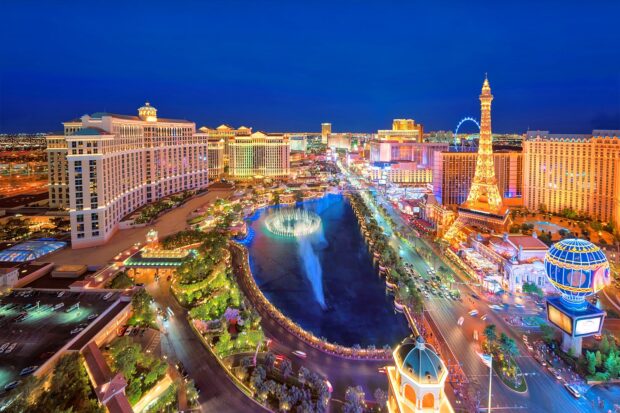By Rob Meyne
- Aug. 29, 2025
- 4-min read
We love living in Las Vegas. There is no location with more to do.
But it is undeniable that the city is not as welcoming to people of ordinary means as it used to be.
It is funny how often I hear “The city was better when it was run by the mob.” I don’t know how true that is, but it was more accessible.
Ordinary Americans should be able to come here and have a good time on a decent budget. Manifestly, they cannot.
There are one-of-a-kind resorts here that give you an unforgettable experience. Places like the Venetian-Palazzo, or Mandalay Bay, or Aria do not disappoint. They have figured it out. There is no city like this, and some of the world’s biggest hotels are here, often full to capacity for weeks on end.
But the focus of many properties has, over time, moved from middle America to the rich and privileged. Lots of resorts have decided that essentially EVERY component of their operation must turn a profit. They are good at tracking expenses and income, but not always good at looking at the entire enterprise. More people will come to your hotel, gamble, and drink, if they don’t have to pay so much for parking, etc. But they miss that.
You used to be able to park for free, eat inexpensively, enjoy free drinks while playing, and probably see a decent show for little or nothing. You may have noticed the casinos didn’t go broke. They thrived. Now they charge ridiculous resort fees (which is just additional profit), outrageous parking fees, ludicrous prices for drinks, and there are very few affordable restaurants.
I was in a discussion once where a casino executive said, “Parking facilities are expensive, so why shouldn’t our visitors pay for it?” “For the same reason,” I said, “That you can still park at the mall, doctor’s office, or Applebee’s for free.” Heating and cooling are expensive, too, but they don’t charge you for it separately. They did not get the point or find it amusing.
Last week we had a friend in town who wanted to eat on the Strip. So, we went to Netflix Bites (which is not a commentary on their programming), a themed place at MGM. Five people. One ordered steak frites, another a cheeseburger, then a pasta dish, nachos, and a club sandwich. No drinks. It was ok, not great. If I had the same meal at Denny’s I would have said it was fine, but nothing special.
$250 before tip. There is zero chance we’ll go there again. If you get the urge to try it, please notify me so I can talk you out of it.
City leaders can claim the drop in visitation isn’t a Las Vegas issue, but not all the factors affecting us are global. The least responsible or credible thing businesspeople can do, when business takes a downturn, is to claim there is nothing you can do about it. There always is.
Major resorts are saying they are trying to bring in more business by lowering or eliminating parking charges and resort fees. They also claim those same expenses are not keeping people away. Uh… if those expenses aren’t driving away business, why would changing them bring it back? It IS about money. Of course it is. It always is.
A few years ago, the city sold its soul to F1 to bring a race here. It is cool to have one here. Sounds like a good idea, right?
But average people can’t afford to attend. And the annual event disrupts the daily lives of tens of thousands of people, for months on end, because they are constantly building, tearing down, and rebuilding the infrastructure. They are inconvenienced just trying to live their lives, but they get little or no benefit from the event itself.
There is also no way for most locals to participate in F1. Most major events – the Super Bowl, Kentucky Derby, Indy 500 – have a lot of ways for folks to enjoy the festivities, often at a decent price. Not F1 Las Vegas.
And, for about a third of the year, conservatively, things that people come here to see – think the Bellagio Fountains – aren’t fully visible or accessible because the streets and sidewalks are blocked. If you’re a crown prince or a billionaire, F1 is a good gig. If you are a teacher, cop, or firefighter, not so much.
This is a great city and one of the few truly unique locales one can call home. But it is not as affordable for mainstream America as it was once. Las Vegas will face tough years ahead if they continue to cater only to the richest among us.
The city leaders and the businesses who pull their strings have decided Las Vegas should not appeal to average people. They didn’t announce it, of course, but they made the decision to abandon middle America by making thousands of individual choices that rose the price of everything from taxis to uber to steaks to beer to parking. Having priced everything out of sight, it is hard to see how they can roll it all back.
Or maybe it is easy: lower your prices. But business models that depend on people paying $20 for a beer will be put to the test.
EVERY new property and restaurant wants to be the nicest, most elite, snootiest, etc. But sometimes people just want a decent meal and cocktail for a reasonable price. There are very few places to eat near the Strip that are priced decently. That is why the few that are, like Ellis Island, are crowded.
Vegas will survive but things will remain a bit more challenging than they need to be until someone in charge realizes there are more people who can pay 6 or 8 dollars for a beer than the 15 or 20 most places charge. I recently had a bourbon on the rocks, just a decent but not spectacular pour, for which they asked $35.00. One shot. I declined and didn’t stay around long enough to see if they actually inserted the drink where I suggested.
There is a vast, underserved market, and the next big winners in NV will be the people who figured out how to serve it.



